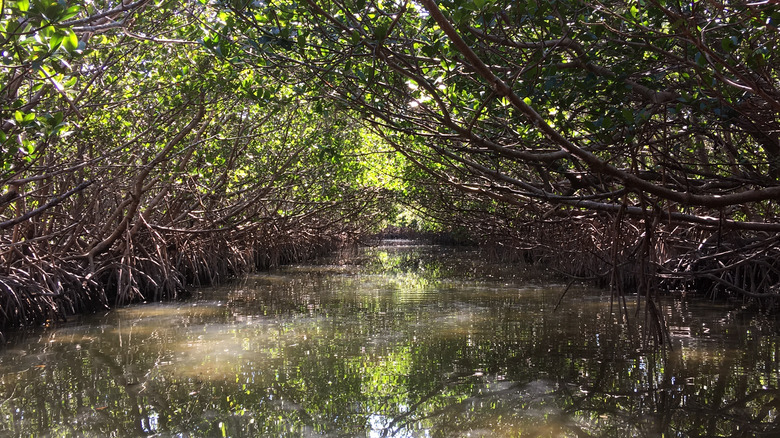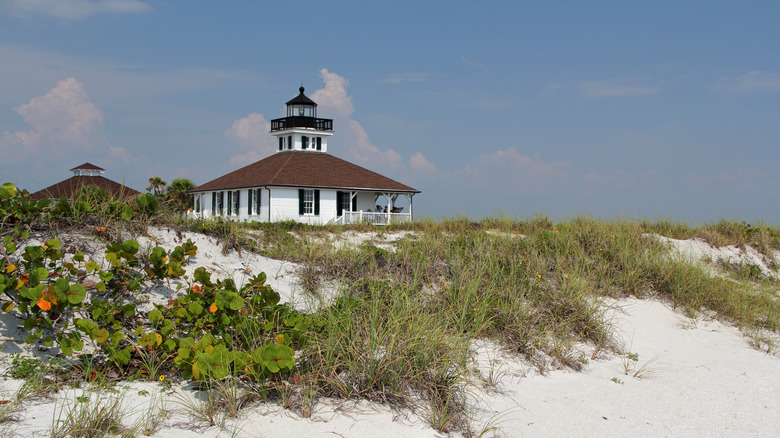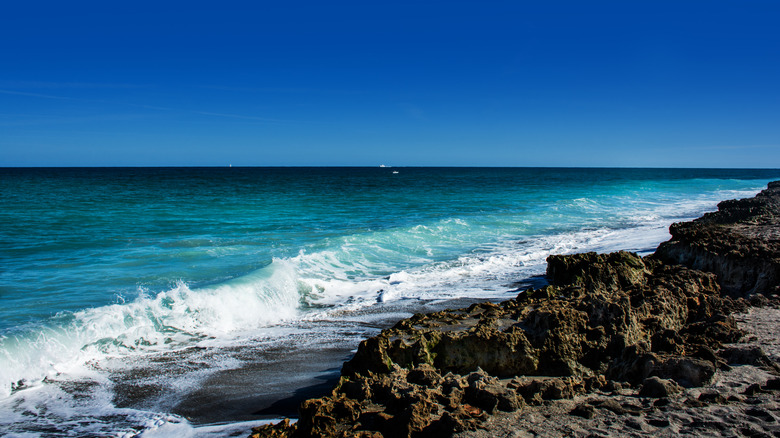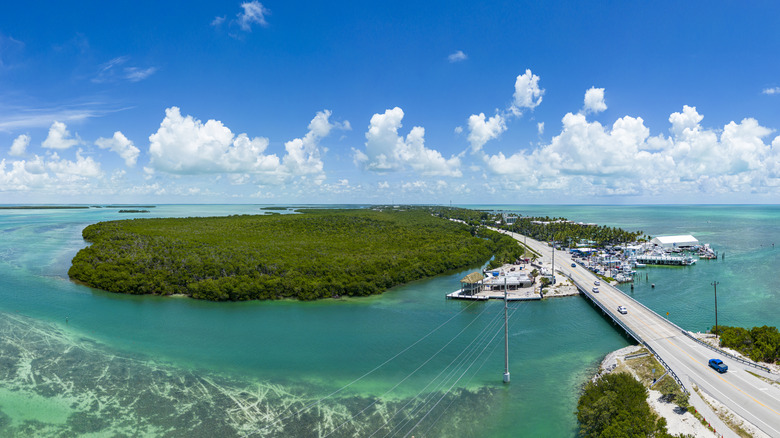10 Top-Rated Islands In Florida To Visit On Vacation
A state known for its vast coastline, Florida is the realm of many islands — thousands of them, in fact. The upshot is that visitors to the Sunshine State can be overwhelmed with choices when it comes to choosing an island destination. Want nature or manmade attractions? Easy access or an isle that promises that increasingly elusive sense of remote escape?
A good road system and a sound tourism infrastructure mean that Florida is a great place to visit all year round. The state has something for everyone, and there are a number of timeless things to do in Florida that make it a fantastic destination. Narrowing down the choices, however, isn't always an intuitive exercise or one that can simply be solved through sanguine logic. That's why we've trawled through travel sites and blogs, researched tourism information, and drawn on our travels in the state to find a list of the best of the best islands in Florida.
Amelia Island
Located just 30 minutes by car from Jacksonville, on the Atlantic Ocean, Amelia Island is a charming, old-style destination with quaint independent shops and a relaxed atmosphere. It's not the slick, shiny, glitzy, buzzing hot spot that other parts of the state offer, but a refuge of simple pleasures. It's also small, measuring only 13 miles in length and a couple of miles at its widest point. Visitors are often drawn by the area's nature, with tranquil beaches on the Atlantic side and marshes around the estuaries where Amelia Island faces the mainland.
The outdoors also pulls in sporty types, from those who like to explore the coastline and waterways on a kayak, to visitors whose idea of a perfect day out is to swing and putt through 18 holes of golf. Or, for a rush, you can skydive and make landfall on the beach. State parks also offer more options for exploration, as well as a dive into history. Fort Clinch State Park features a fort that dates to the time of the Civil War that history buffs will find a thrilling destination. Amelia Island is also home to the oldest lighthouse in the state.
The core of the island, the downtown of Fernandina Beach, is where the charm quotient is turned up a few notches. It retains the feel of a storied small town, with buildings from the Victorian era and small boutiques that sell art, clothing, and crafts. It also has a lively dining scene with a handsome variety of choices. Luxe accommodations include the well-reviewed Ritz-Carlton, Amelia Island.
Anna Maria Island
This slender, gently curling island on the Gulf of Mexico, due west of Bradenton, is another place to soak in the heady vibes of "Old Florida." Life on Anna Maria Island is pleasantly slow, even though it's only an hour away by car from Tampa's busy international airport. The joy of visiting here is that you really don't need a car to get around. Just leave it at your hotel or vacation rental and take public transport. The Anna Maria Island trolley makes the journey from Coquina Beach on the south of the island up to the City Pier by the marina in the north. Better yet, the trolley is free and air-conditioned. So, no worries about getting lost or finding and paying for parking, and with a bus every 20 minutes during the daytime, there's never an interminable wait.
During a stay here, visitors will come to appreciate the low-rise buildings and the ease of exploring the island's canals or indented coastline on a kayak. Along with beaches with super-soft sand, the water can feel as comforting as a warm bath. Travelers might see dolphins or manatees in those waters throughout the year, while early summer is when turtles come onto the beaches to lay their eggs in the sand. The area's excellent bird watching also means the chance to spot wild parrots, pelicans, terns, and herons. Dining includes casual restaurants and ice cream parlors that manage to perfectly embody the languid island vibe.
Caladesi Island
On a map, Caladesi Island might be physically connected to Clearwater Beach Island, but there is no obvious way to get between the two, apart from an arduous walk across unpaved terrain that is only possible at low tide. This wasn't always the case, and the two were formerly separated by Dunedin Pass. That said, even today, both in spirit and ambiance, Caladesi Island really is its own realm. A state park, it's an arena of untouched wilderness and offers a great beach escape.
To get here requires taking a ferry from Honeymoon Island State Park via a 20-minute ride. It brings visitors onto a pristine realm of silky beaches, trails that are perfect for a first solo hike, and clear waters that make this a great island for snorkeling. Private boats can also make the journey to the island and dock in an area of slips on the eastern part of the island.
Once here, apart from the standard state park facilities of restrooms and a rudimentary setup selling food, drinks, and renting kayaks, visitors will find they are left to their own devices. The long beach is a slice of paradise, and an obvious focal point, stretching three miles along the Gulf of Mexico and enlivened by tons of shells. Kayakers can enjoy paddling around the mangroves and channels, with loop kayaking trails offering a set route. There are also hiking trails that wind through the oak and slash pine forest and a bird sanctuary — look out for piping plovers, brown pelicans, and American oystercatchers.
Dry Tortugas National Park
Located 70 miles west of Key West, this grouping of seven small cays has attractions that are both natural and manmade. Dry Tortugas National Park is about 100 square miles in size, but what sets it apart is that only about 1% of that area is land. Getting here requires taking passage on a boat or booking a seat on a seaplane. Once here, visitors can wander around the old fort, as well as snorkel and dive among some of the country's finest dive sites. Its remoteness (past the Florida Keys) has helped the waters to stay clean and clear, while the predominant currents ensure that marine creatures congregate here in sizable numbers.
For many, the highlight of the visit is the snorkeling in crystal-clear, warm water. Many sites avail themselves to visitors who love exploring the water. On the moat wall, aquatic life includes squid, nurse sharks, and hogfish. A real adventure is a chance to snorkel or dive around the moat wall at night, a time when octopus, lobster, shrimp, starfish, and various crabs reveal themselves.
By the pilings of old piers built in the 1800s by the U.S. Navy, tarpon, barracuda, and grouper are commonplace. But it's not just the sea that is ripe for exploration. On land, Fort Jefferson National Monument is a stunning piece of architecture, with ornate brickwork and about 2,000 arches around the structure that will dazzle day-trippers as much as the sea.
Gasparilla Island
The slim island northwest of Fort Myers is a tale of two halves — at least in atmosphere if not strict geometric dimensions. The bottom part of the island is home to the Gasparilla Island State Park, whose waters are nirvana for fishermen. Fishing has a long history here, going back to the days of the indigenous Calusa tribe and later the Spanish, who built camps along the coast and exported the fish they caught to Cuba. It was in the 1900s that the reputation really grew when these waters garnered themselves praise as the "Tarpon Capital of the World." Even today, anglers descend on the seas around the state park in the hope of catching the prized fish. The waters are also home to manatees.
On land, visitors might spot tortoises, bald eagles, and terns. The park also boasts fine beaches, and the Port Boca Grande Lighthouse Museum on its southern end, which examines the island's anthropological and economic past, features old bones and fossils. Elsewhere on Gasparilla Island, visitors will find quiet roads with private homes and the main settlement of Boca Grande. This hub features small independent stores, places to eat, and great beachcombing, with shark's teeth sometimes washed up amid the banks of sea shells. This is an easy place to escape the world via serene sunset walks on the beach. The Gasparilla Inn & Club has a fun beach vibe, with rooms split among the main building, cottages, and villas.
Jupiter Island
Connected to the mainland by a couple of bridges, Jupiter Island is slender, with one main road slicing up and down the island. A beach lines the entire east coast, from top to toe, facing the turquoise waters of the Atlantic Ocean, and the stretch of sand supplies some fine beaches. The island alternates between pockets of dense development, with some expensive, exclusive homes in private communities, and areas of untouched wilderness. In the south, at Jupiter Inlet Colony, homes are packed across the land. Just to the north is Coral Cove Park, a slash of greenery that looks onto the Atlantic beaches and the Intracoastal waterway.
A short distance further north is one of the most exciting sights on the island. The Nature Conservancy Blowing Rocks Preserve is part of a restoration project aimed at safeguarding endangered Florida ecology. Here, these include fauna like loggerhead and leatherback sea turtles, as well as a rare rocky shoreline made of Anastasia limestone, the most comprehensive of its type on the U.S. Atlantic. On a day of strong waves, the water smashing against this jagged coast can produce soaring towers of spray that shoot 50 feet up in the air. Elsewhere, visitors can stand-up paddle board, paddle in a clear kayak, and snorkel and dive at St. Lucie Inlet Preserve State Park, located on the island's northern cusp. As a note, travelers looking to stay on the island will need to rent a vacation home.
Marco Island
Look at this island near Naples on a map, and it appears like a jumble of jigsaw pieces haphazardly smushed together. However, with all the inlets, channels, and waterways here, boat access makes Marco Island a haven for yachties. Many homes have a dock attached, and there are plenty of places for visitors to rent a boat. They can also just hit the water on a kayak and canoe, such is Marco Island's ubiquitous connection to the sea.
Marco Island certainly feels very developed, crammed with homes, businesses, stores, a golf course, and a number of large luxury resorts. Great dining, shopping, and art also pull people in. On the north of the island, LeeBe Fish combines a seafood market with a restaurant — so you can be sure that the catch is fresh. Seafood is served in a combination of mediums, from sandwiches to tacos to platters to simple baskets, fried or lightly charred.
Reviews on Tripadvisor laud the artwork at Betty Newman Art, with work by local artists proudly featured among the collections. Shopping is an intimate affair at the small stores around the island, with Collier Blvd one of the main drags. South Collier Blvd is also where to find upscale resorts on Marco Island, many promising direct access to the sultry beaches on the Gulf of Mexico.
St. George Island
Sitting across from Apalachicola in the Panhandle, across a bridge from the mainland, this long island has stunning sugar-sand beaches and a low-key sensibility that makes it a restorative, engaging escape. The buildings here are all low-rise, and though St. George Island combines areas of development with large slashes of nature, it still feels extremely relaxed. It stretches for more than 20 miles between Apalachicola Bay and the Gulf of Mexico, but at only a mile wide, the island sits in the water like a giant check mark.
Families will enjoy their time on the island, with many miles of paved biking paths, as well as great swimming and amazing kayaking adventures. This is also the realm of sea turtles and coastal birds, while anglers will gush over the rich array of fish — easily caught from the shore or on a boating excursion. Fish commonly caught around St. George Island include snapper, sea bass, grouper, and speckled trout.
Family groups can also enjoy a multitude of diversions at Dr. Julian G. Bruce St. George Island State Park. For starters, the beaches are spectacular, with sugar-soft sand, dazzling emerald waters, and dolphins often arcing in the sea. On the bay side of the park, bird life thrives, evident from the walking trails that meander through pine trees and areas of scrubby bush. Look up and you might see a bald eagle or hear a woodpecker. After exploring, you'll find plenty of dining options on the island, including seafood, pizza, and food trucks.
St. Vincent Island
Sitting above one end of St. George Island, this isle near Apalachicola promises a total escape. There is no development here, no roads, and no facilities, making the island as untouched as nature intended. It is 12,300 acres in size and forms the vast majority of the St. Vincent National Wildlife Refuge, which encompasses this island, Pig Island, and small parcels on the Florida mainland. You can only get here by boat, which adds to the welcome sense of separation.
Once on the island, visitors will find themselves immersed in a cloud of complete quietude, with the chance to hike, fish, cycle, look out for wildlife, or kayak and swim in the clear waters offshore. The handful of thoroughfares here are made of sand, suitable for walks or a leisurely bike ride, but signs are limited, so getting lost is part of the experience.
The beaches are similarly wild, and elsewhere, there are sections of cabbage palms and swathes of marshland where birds feed. Birds are, in fact, especially common here, since the refuge is an important migratory stop for many species, including some that are endangered. You might spot gulls, terns, bald eagles, ospreys, and grackles. Other island sightings include white-tailed deer, loggerhead turtles, and endangered red wolves, which breed in the refuge. The hunting season runs from November to January, a time when waterfowl arrive in numbers. The refuge closes to the general public during this period.
Upper Matecumbe Key
One of the islands that make up Islamorada, a collection of keys in Southern Florida, Upper Matecumbe Key has it all. The sea is a good place to start, which is typically calm and clear with an inviting emerald-turquoise hue. Guests can enjoy great snorkeling and paddleboarding through excursions with Clearly Unique Charters. Travelers can go out onto the reef to see tropical fish or make a stop on a sandbar to enjoy the sensation of standing in shallows while surrounded by deep water.
You can also get a handle on the riches of sea exploration back on land at the History of Diving Museum. It's a fascinating and sobering look at how diving has evolved, with some pretty ancient-looking diving equipment — yes, it was all actually used and worked — bringing the history to life. Equally fascinating is the Keys History & Discovery Center, located within the Islander Resort. It features displays on a variety of topics, from Native American history to pirates. Also, you can find out about centuries-old Spanish fleets and the network of the local coral reef, represented in a series of aquariums. There are places to stay on the island, but none are quite as polished as Cheeca Lodge & Spa. It sits on 27 waterfront acres, has rooms in blues and whites, and a spa where relaxation is guaranteed.
Methodology
To find the islands in Florida that really shouldn't be missed, we trawled through travel review sites like Tripadvisor, blogs that focus on the Sunshine State, forums like Reddit, state and national parks pages, real estate materials, and researched official tourism information. We have also drawn on our travels in the state to help compile this list.
While Southern Florida and the Keys might get a large slice of the media coverage on the state, we fully appreciate that there is much more to Florida than that small bit. So, we have endeavored to give a balanced representation of all the state's riches here. This is why we included islands in the Panhandle, on the Gulf Coast, in the Keys, and up the Atlantic.











